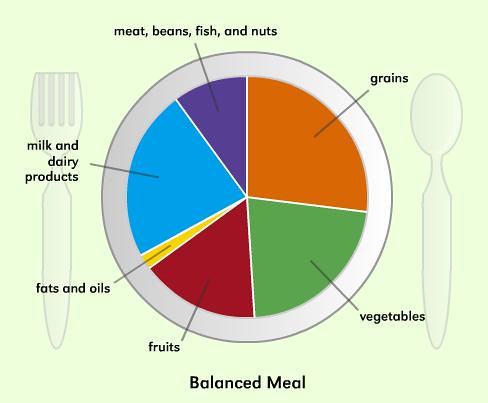
Photo courtesy of Creative Commons: The district lunches include foods from each of these food groups to ensure students are getting all the necessary nutrients and staying healthy in quarantine.
How AUSD lunches align with food pyramids
According to the district’s Food and Nutrition Department website, “the winning recipe for a healthy lifestyle includes a combination of both good nutrition and physical activity.” Not only does good nutrition contribute to a healthy lifestyle, it also correlates to improved test performance and classroom behavior. The district’s lunch program during distance learning achieves this winning recipe and ensures students are at their peak academic performance by providing them with a balance of food groups in their meals.
The school meals always include a side of vegetables such as carrots and cucumbers and, occasionally, fruit. This makes sure that students are receiving the necessary nutrients and vitamins. Vegetables and fruits should make up about half of the plate, which is a portion that the lunches follow. This food group helps reduce the risk of chronic diseases and provides nutrients vital for the health and maintenance of the body. Variety in vegetables is key, as different types of vegetables provide different nutrients, so eating only one type deprives oneself of other nutrients.
The school meals always have protein in a wide variety too, such as corn dogs, sandwiches, and tacos. Proteins are an important source of energy for the body, as it helps build and repair tissue. Proteins ferry helpful nutrients throughout the body and support immune function, which is more important now than ever. Common sources of protein include beef, seafood, eggs, and nuts, and should take up about a quarter of the plate.
Carbohydrates are always present in school lunches, usually in bread or rice, although the serving can be excessive such as in the Pick Up Stix meals. Carbohydrates and grains help reduce blood cholesterol levels and lowers the risk of health conditions such as heart disease, obesity, and Type 2 diabetes. This food group also provides necessary nutrients such as vitamin B, magnesium, and selenium. Carbohydrates and grains also have lots of fiber to help one feel fuller longer.
The school provides a quart of milk in the school lunch bags, which satisfies the recommended dairy serving for two days. Dairy products provide vitamins such as calcium and potassium. Calcium intake is linked to improved bone health, and potassium helps maintain healthy blood pressure. Dairy can also reduce the risk of bone and cardiovascular diseases as well as Type 2 diabetes. Common sources of dairy are milk, yogurt, and soy milk.
The district’s lunches provide students with the nutrients needed for peak academic performance. Appropriate servings for all the food groups in every lunch allows students to stay energized and alert during distance learning.